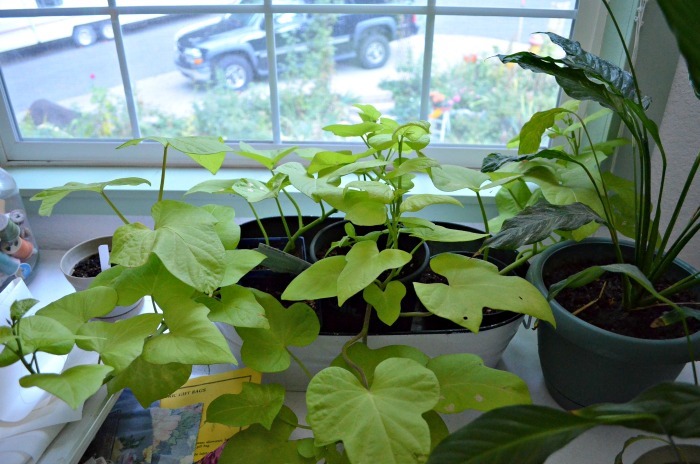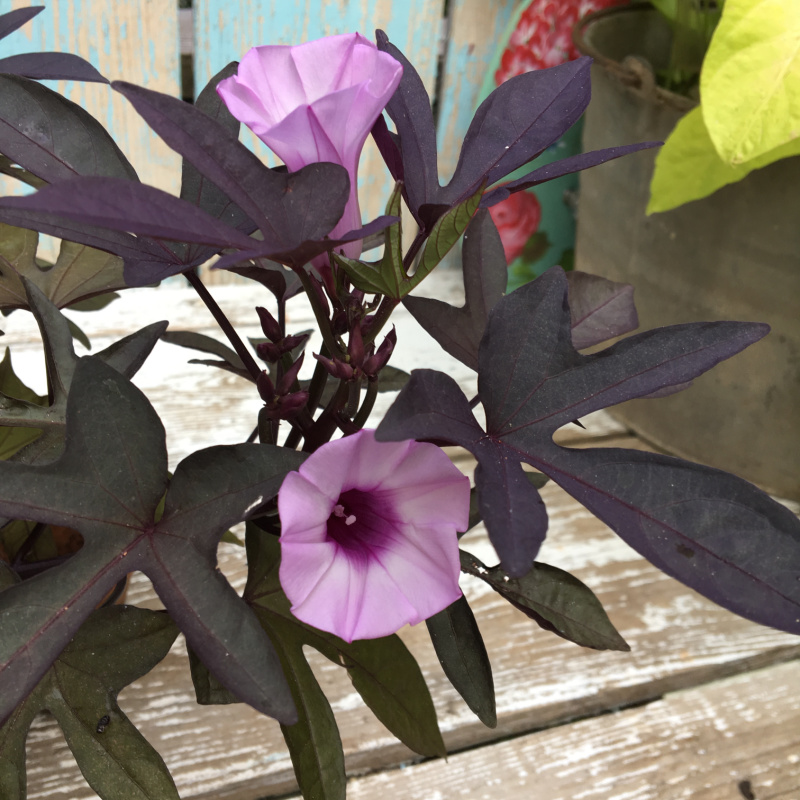How To Grow Sweet Potato Vines
Cultivating Beauty: A Guide to Growing Ornamental Sweet Potato Vines
I love to grow ornamental sweet potato vines (Ipomoea batatas)! Let me show you how to grow sweet potato vines in your garden, pots and containers. They are versatile and vibrant tropical plants that can add a flamboyant touch to your garden, window boxes, garden bed, or landscape.

This post contains affiliate links. If you make a purchase after clicking a link I may make a small commission at no cost to you.
Known for their attractive foliage in various colors and shapes, these vines are relatively easy to grow, making them a popular choice for both newbies and experienced gardeners.
But fair warning, ornamental sweet potato vines do not make tasty tubers like regular potatoes.
For more on great trailing plants for your pots see this article!
In this guide, we’ll explore the steps to successfully cultivate ornamental sweet potato vines and enhance the beauty of your outdoor space or large containers.

This post contains affiliate links. If you make a purchase after clicking a link I may make a small commission at no cost to you.
What you will discover today:
- Choose the Right Variety
- Optimal Growing Conditions
- Prepare the Soil
- Proper Planting
- Regular Watering
- Fertilize Appropriately
- Pruning for Bushier Growth
- Pest and Disease Management
- Overwintering Considerations
- Enjoy the Beauty
Selecting the Right Variety
When choosing ornamental sweet potato vines, consider the specific variety that best suits your color scheme, design, and garden conditions.
Varieties like ‘Marguerite,’ ‘Blackie,’ and ‘Sweet Caroline’ are renowned for their colorful foliage, ranging from deep purples to vibrant greens.
Some are rampant growers and need trimming to keep tidier while others are well-mannered.

Choosing the Ideal Location
Ornamental sweet potato vines thrive in full sun, so choose a location with at least six hours of direct sunlight per day. Provide well-drained soil, these plants prefer slightly moist conditions not soaking wet.
Container gardening is also a popular option, allowing you to control soil quality and easily move the plants. Being tropical plants they like high humidity, rich soil, and warm climates.
If you have extremely high summer heat you can provide some shade during the hottest part of the day. (or if planted with taller plants they may provide enough shelter)
Soil Preparation
Prepare the soil by incorporating organic matter such as compost or well-rotted manure. This acts as a slow-release fertilizer, enhances soil fertility, and provides the vines with essential nutrients. This also helps with good drainage and prevents root rot.
Ornamental sweet potato vines prefer moderately rich soil but they are tolerant of varying pH levels and soil types as long as the soil is well-draining.
All the best garden tips
Build Great Soil!
Building your organic garden soil is essential for long-term gardening success. Here you will learn the best tricks for great garden soil. Beginner gardener friendly!
Planting
Plant ornamental sweet potato vines after the last frost in your region, they are not cold hardy. Space the plants about 12 to 18 inches apart, allowing them room to spread.
Be sure to read the tag and instructions, some can be planted closer together and are less aggressive than others.
When planting in containers, choose a pot with plenty of drainage holes to prevent waterlogged roots.
Watering
Ornamental sweet potato vines do require regular watering, especially during dry periods. Keep the soil consistently moist but not waterlogged. (repetition for emphasis)
Mulching around the plants helps retain moisture and suppress weeds.
Fertilization
Apply an all-purpose fertilizer every 4-6 weeks during the growing season to support the vigorous growth of the vines.
As with any plant less is more, try not to overfertilize. This is one of my favorite water-soluble fertilizers as it feeds the soil as well as the plants.
Pruning and Maintenance
Regular pruning or pinching back encourages bushier growth and enhances the ornamental appeal of the vines. Pinch back the tips and remove any yellow or damaged leaves.
Pruning also helps control the size of the vines, making them suitable for various garden settings. This also helps to keep the more aggressive varieties in check, they can overwhelm other plants in a pot or container if not managed.
What is fabulous is you can use the trimmings to propagate more of these gorgeous plants.
Propagate Sweet Potato Vines
Ornamental Sweet potato vine is easy to propagate from cuttings. Not only can you get more sweet potato plants throughout the summer but you can overwinter cuttings in a sunny windowsill..
Pest and Disease Management
Keep an eye out for common pests like aphids and spider mites. Treat any infestations promptly. I prefer spraying off the leaves weekly with a power nozzle on my hose, this keeps both in check without any harmful chemicals.
Ornamental sweet potato plants are generally resistant to diseases, but proper care and sanitation can prevent potential issues, like fungal infection.
I have not had many problems with fungal diseases or many pests but I have heard of folks contending with sweet potato weevils and flea beetles.
Overwintering
In colder climates, ornamental sweet potato vines are typically grown as annuals. However, in warmer regions, they may survive the winter. I
f you intend to overwinter the plants, before the danger of frost, cut them back and cover the tuberous roots with a thick layer of mulch to protect them from frost. Or sever a few stem cuttings below the leaf nodes and place them in water in a sunny window.
Some dig up the sweet potato tubers and overwinter them in a cool dry place then replant after the last frost. Experiment and find the best way to overwinter for your circumstances.
You will have plenty for next year.

Enjoying the Results
With proper care, ornamental sweet potato vines will reward you with lush, colorful foliage throughout the growing season and maybe even some flowers that resemble morning glory.
Whether cascading from hanging baskets, adorning garden beds, or spilling over the edges of containers, these vines will fill in, spill over, and act as a great ground cover.
Growing ornamental sweet potato vines is a delightful and rewarding experience, bringing a burst of color and texture to a sunny location in your garden. You may even get some to bloom!
Don’t they look like morning glories?

Here are seven popular ornamental varieties, each known for its unique characteristics:
‘Marguerite’ (Ipomoea batatas ‘Marguerite’)
- Foliage: Chartreuse to bright green.
- Features: Heart-shaped leaves with a trailing habit.
- Use: Ideal for containers, hanging baskets, or as ground cover.
- ‘Blackie’ (Ipomoea batatas ‘Blackie’):
- Foliage: Deep purple to almost black.
- Features: Contrasts well with other plants, creating a dramatic effect.
- Use: Adds a touch of elegance to mixed container gardens and landscapes.
‘Sweet Caroline’ (Ipomoea batatas ‘Sweet Caroline’)
- Foliage: Comes in various colors, including sweet potato vine varieties with chartreuse, bronze, and purple leaves.
- Features: Versatile and adaptable to different growing conditions.
- Use: Great for adding texture and color to both sunny and partially shaded areas. The colors are not as intense in shadier conditions but still beautiful.
- ‘Tricolor’ (Ipomoea batatas ‘Tricolor’):
- Foliage: Variegated with shades of pink, green, and white.
- Features: Striking and colorful leaves add visual interest.
- Use: Perfect for containers, hanging baskets, or as an accent in garden beds.
‘Desana Lime’ (Ipomoea batatas ‘Desana Lime’)
- Foliage: Lime green with a vigorous trailing habit.
- Features: Bright and refreshing color, cascades gracefully and yet is more compact.
- Use: Excellent for hanging baskets and container gardens.
- ‘Illusion Midnight Lace’ (Ipomoea batatas ‘Illusion Midnight Lace’):
- Foliage: Deep purple-black with deeply lobed leaves.
- Features: Unique and intricate foliage pattern.
- Use: Adds a touch of mystery and sophistication to garden arrangements.
‘SolarPower™ Black’ (Ipomoea batatas ‘SolarPower™ Black’)
- Foliage: Intense black-purple.
- Features: Compact and mounding growth habit.
- Use: Ideal for edging, borders, or as a focal point in container gardens.
It’s always a good idea to experiment with different varieties, planting arrangements, and combinations to create a stunning display showcasing these versatile plants’ beauty.
It seems like there are always new plants added so keep your eye out for different varieties.
Remember to adapt these guidelines based on your specific growing conditions and preferences. Cultivating ornamental sweet potato vines can be a delightful and creative endeavor.
Feel free to ask more questions or seek additional advice based on your specific circumstances and gardening goals.







